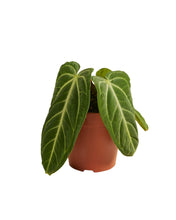Anthurium villenaorum is a rare and highly sought-after aroid prized for its large, velvety, bullate (puckered) leaves. This epiphytic plant, native to Peru, is a favourite among collectors for its unique foliage and dramatic appearance. It belongs to the Araceae family.
The genus name Anthurium comes from the Greek words anthos (flower) and oura (tail), referring to the characteristic spadix (the "tail") and spathe (the modified leaf surrounding it) of the flower. Villenaorum is named after the Peruvian city of Villa Rica, where the plant was first discovered.
Light: Anthurium villenaorum thrives in bright, indirect light. Direct sunlight can scorch the delicate leaves, while insufficient light can lead to slower growth and less pronounced leaf texture. A spot near a window with filtered light, or a room with ample ambient light, is ideal.
Water: Anthurium villenaorum prefers consistently moist, but not soggy, soil. Allow the top inch or two of soil to dry out slightly between waterings, but avoid letting the soil dry out completely. Water thoroughly when you do water, ensuring any excess water drains away. Overwatering can quickly lead to root rot, a common problem with this species.
Potting mix: A well-draining, airy potting mix is absolutely vital. A blend of potting soil, perlite, orchid bark, and sphagnum moss is a good choice. Avoid mixes that retain too much moisture. A chunky mix, similar to what you might use for orchids or other epiphytic plants, is beneficial.
Fertilising: Feed your Anthurium villenaorum with a diluted balanced liquid fertiliser every 4-6 weeks during the growing season (spring and summer). Reduce or stop fertilising during the autumn and winter months.
Temperature: Anthurium villenaorum prefers warm temperatures, ideally between 21-27°C. It is not frost-tolerant and should be protected from cold conditions. Avoid placing it near draughts or heating/cooling vents.
Humidity: This Anthurium is a high-humidity lover. Using a humidifier or growing in a cabinet or indoor greenhouse can be very helpful. Low humidity can lead to crispy leaf edges and hinder growth.
Support: As an epiphyte, Anthurium villenaorum often benefits from having a support to climb on, such as a moss pole or plank. This can mimic its natural growing conditions and encourage larger, more impressive leaves.
Toxicity: Anthuriums are toxic if ingested, so keep it away from pets and small children. The sap can also be irritating to the skin.



